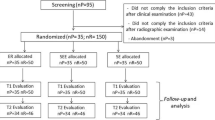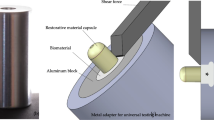Abstract
Objective
The objective of this study was to analyse the failure mode of adhesive interfaces by comparing OCT and scanning electron microscope (SEM) analysis of class V restoration margins located on enamel and dentin.
Materials and methods
Three groups were tested that differed in the application of a 3-step etch-and-rinse adhesive system (OptiBond FL) prior to cavity filling with restorative composite resin (Clearfil AP-X). After tooth restoration and polishing, the samples were loaded in a fatigue machine, and adhesive interfaces were evaluated with OCT and SEM.
Results
Important and complementary information could be obtained with OCT analysis in respect to how marginal defects can propagate inside the cavity, compromising the restoration’s long-term performance. A self-etching effect was observed with OptiBond FL due to the presence of an acidic primer (GPDM) within its composition. Our results could show that areas of bonding and gaps coexisted within the same restoration.
Conclusions
When marginal imperfections, or non-continuous margins, were detected by SEM, also imperfections beneath the surface could be observed at the tooth-restoration interface with OCT. Restoration loss occurred above the borderline of 50 % of marginal gaps on enamel and dentin.
Clinical relevance
Marginal discrepancies of adhesive restorations can propagate inside the cavity and lead to restoration loss.







Similar content being viewed by others
References
Aschenbrenner CM, Lang R, Handel G, Behr M (2012) Analysis of marginal adaptation and sealing to enamel and dentin of four self-adhesive resin cements. Clin Oral Investig 16:191–200
Behr M, Hansmann M, Rosentritt M, Handel G (2009) Marginal adaptation of three self-adhesive resin cements vs a well-tried adhesive luting agent. Clin Oral Investig 13:459–464
Krejci I, Lutz F (1990) In-vitro results of the evaluation of dental restoration systems. Correlation with in-vivo results. Schweiz Monatsschr Zahnmed 100:1445–1449
Mayoral JR, Gregor L, Campos EA, Roig M, Krejci I (2011) Marginal seal stability of one bottle adhesives in class V vs class I cavities. Clin Oral Investig 15:257–264
Rechenberg DK, Höhring TN, Attin T (2010) Influence of different curing approaches on marginal adaptation of ceramic inlays. J Adhes Dent 12:189–196
Roggendorf MJ, Krämer N, Appelt A, Naumann M, Frankenberger R (2011) Marginal quality of flowable 4-mm base vs. conventionally layered resin composite. J Dent 39:643–647
Van Dijken JW, Pallesen U (2011) Clinical performance of a hybrid resin composite with and without an intermediate layer of flowable resin composite: a 7-year evaluation. Dent Mater 27:150–156
Bracket MG, Dib A, Franco G, Estrada BE, Brackett WW (2010) Two-year clinical performance of Clearfil SE and Clearfil S3 in restoration of unbraded non-carious class V lesions. Oper Dent 35:273–278
Heintze SD, Forjanic M, Roulet JF (2007) Automated margin analysis of contemporary adhesive systems in vitro: evaluation of discriminatory variables. J Adhes Dent 9:359–369
Frankenberger R, Krämer N, Lohbauer U, Nikolaenko SA, Reich SM (2007) Marginal integrity: is the clinical performance of bonded restorations predictable in vitro? J Adhes Dent 9:107–116
Burke FJ, Cheung SW, Mjör IA, Wilson NH (1999) Restoration longevity and analysis of reasons for the placement and replacement of restorations provided by vocational dental practitioners and their trainers in the United Kingdom. Quintessence Int 30:234–242
Sarrett DC (2005) Clinical challenges and the relevance of materials testing for posterior composite restorations. Dent Mater 21:9–20
Kern M, Strub JR, Lü XY (1999) Wear of composite resin veneering materials in a dual-axis chewing simulator. J Oral Rehabil 26:372–378
Mörmann W, Brandestini M, Ferru A, Lutz F, Krejci I (1985) Marginal adaptation of adhesive porcelain inlays in vitro. Schweiz Monatsschr Zahnmed 95:1118–1129
Puschmann D, Wolfart S, Ludwig K, Kern M (2009) Load-bearing capacity of all-ceramic posterior inlay-retained fixed dental prostheses. Eur J Oral Sci 117:312–318
Sakaguchi RL, Douglas WH, DeLong R, Pintado MR (1986) The wear of a posterior composite in an artificial mouth: a clinical correlation. Dent Mater 2:235–240
Zysk AM, Nguyen FT, Oldenburg AL, Marks DL, Boppart SA (2007) Optical coherence tomography: a review of clinical development from bench to bedside. J Biomed Opt 12:051403
Azevedo CS, Trung LC, Simionato MR, Freitas AZ, Matos AB (2011) Evaluation of caries-affected dentin with optical coherence tomography. Braz Oral Res 25:407–413
Braz AK, Aguiar CM, Gomes AS (2011) Evaluation of the integrity of dental sealants by optical coherence tomography. Dent Mater 27:e60–e64
Ishibashi K, Ozawa N, Tagami J, Sumi Y (2011) Swept-source optical coherence tomography as a new tool to evaluate defects of resin-based composite restorations. J Dent 39:543–548
Makishi P, Shimada Y, Sadr A, Tagami J, Sumi Y (2011) Non-destructive 3D imaging of composite restorations using optical coherence tomography: marginal adaptation of self-etch adhesives. J Dent 39:316–325
Senawongse P, Pongprueksa P, Harnirattisai C, Sumi Y, Otsuki M, Shimada Y, Tagami J (2011) Non-destructive assessment of cavity wall adaptation of class V composite restoration using swept-source optical coherence tomography. Dent Mater J 30:517–522
Krejci I, Kuster M, Lutz F (1993) Influence of dentinal fluid and stress on marginal adaptation of resin composites. J Dent Res 72:490–495
Roulet JF, Hirt T, Lutz F (1984) Surface roughness and marginal behavior of experimental and commercial composites: an in vitro study. J Oral Rehabil 11:499–509
Cirrus HD-OCT User Manual, Zeiss, Germany
Spencer P, Ye Q, Park J, Topp EM, Misra A, Marangos O, Wang Y, Bohaty BS, Singh V, Sene F, Eslick J, Camarda K, Katz JL (2010) Adhesive/dentin interface: the weak link in the composite restoration. Ann Biomed Eng 38:1989–2003. doi:10.1007/s10439-010-9969-6
Garcia-Godoy F, Krämer N, Feilzer AJ, Frankenberger R (2010) Long-term degradation of enamel and dentin bonds: 6-year results in vitro vs. in vivo. Dent Mater 26:1113–1118
Drexler W (2004) Ultrahigh-resolution optical coherence tomography. J Biomed Opt 9:47–74
Erickson RL, Barkmeier WW, Latta MA (2009) The role of etching in bonding to enamel: a comparison of self-etching and etch-and-rinse adhesive systems. Dent Mater 25:1459–1467
Bahillo J, Roig M, Bortolotto T, Krejci I. Self-etching aspects of a three-step etch-and-rinse adhesive. Clin Oral Invest DOI 10.1007/s00784-012-0878-y
Shono Y, Ogawa T, Terashita M, Carvalho RM, Pashley EL, Pashley DH (1999) Regional measurement of resin-dentin bonding as an array. J Dent Res 78:699–705
Van Landuyt KL, Snauwaert J, De Munck J, Peumans M, Yoshida Y, Poitevin A, Coutinho E, Suzuki K, Lambrechts P, Van Meerbeek B (2007) Systematic review of the chemical composition of contemporary dental adhesives. Biomaterials 28:3757–3785
Conflict of interest
The authors declare that they have no conflict on interest.
Author information
Authors and Affiliations
Corresponding author
Rights and permissions
About this article
Cite this article
Bortolotto, T., Bahillo, J., Richoz, O. et al. Failure analysis of adhesive restorations with SEM and OCT: from marginal gaps to restoration loss. Clin Oral Invest 19, 1881–1890 (2015). https://doi.org/10.1007/s00784-015-1402-y
Received:
Accepted:
Published:
Issue Date:
DOI: https://doi.org/10.1007/s00784-015-1402-y




